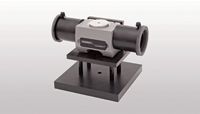An Infrared Investigation of Nail Polish Remover Using Multiple Reflection Diamond ATR
Application Notebook
Multiple reflection ATR is ideal for detecting miniscule levels of components in solutions. If one component is volatile, trace analysis can be simplified by allowing the volatile liquids to evaporate.
Multiple reflection ATR is ideal for detecting miniscule levels of components in solutions. If one component is volatile, trace analysis can be simplified by allowing the volatile liquids to evaporate. A multiple reflection ATR with a small sampling area is advantageous in cases where limited sample is available, as it allows additional concentration of the residue.
This note explores the use of a multiple reflection diamond ATR accessory to detect and identify the minor chemical variability between different types of nail polish remover.
Experimental
Harrick Diamond ConcentratIR2™ (see Figure 1), which supplies seven reflections from the sample, was installed and aligned in a commercial FTIR spectrometer. Spectra were collected at 4 cm-1 resolution and signal averaged over 64 scans. Three nail polish removers — the original, nourishing, and strengthening formulations from the same brand — were analyzed. A single drop of each type was placed on the diamond ATR crystal. Infrared spectra were collected over a range of 4000 cm-1 to 650 cm-1 periodically until the solvent, acetone, had fully evaporated.

Figure 1: ConcentratIR2⢠Multiple Reflection ATR.
Results and Discussion
Many of the new peaks that emerge are present in all three samples. Only a few bands, in the 1600 cm-1 to 900 cm-1 region, as shown in Figure 2, are unique to any given sample. This is in good accordance with listed ingredients which indicates only a few unique substances in the analytes. Unique peaks include a H–C–H alkane bend at 1500 cm-1 , probably from tocopheryl acetate, an ingredient found only in the "nourishing" formula. Characteristic peaks are also observed at 1225 cm-1 and 985 cm-1 which are likely due to panthenol, another element particular to the nourishing formulation. Some other ingredients specific to one formula, such as citric acid (nourishing) and benzophenone-1 (strengthening) are present in quantities too small to be detected. Use of additional reflections or greater concentration of the sample might make these apparent.

Figure 2: ATR spectra of original (black), strengthening (red), and nourishing (blue) nail polish removers.
Conclusion
The ConcentratIR2™ can be used effectively to measure trace differences in residues of complex solutions. Since the crystal is also only 4-mm in diameter, only single drops of the sample are required, making it extremely useful in situations where only limited quantities of sample area available.
Harrick Scientific Products, Inc.
P.O. Box 277, Pleasantville, NY 10570
tel. (800) 248-3847, fax (914) 747-7209
Website: www.harricksci.com

Thermo Fisher Scientists Highlight the Latest Advances in Process Monitoring with Raman Spectroscopy
April 1st 2025In this exclusive Spectroscopy interview, John Richmond and Tom Dearing of Thermo Fisher Scientific discuss the company’s Raman technology and the latest trends for process monitoring across various applications.
A Seamless Trace Elemental Analysis Prescription for Quality Pharmaceuticals
March 31st 2025Quality assurance and quality control (QA/QC) are essential in pharmaceutical manufacturing to ensure compliance with standards like United States Pharmacopoeia <232> and ICH Q3D, as well as FDA regulations. Reliable and user-friendly testing solutions help QA/QC labs deliver precise trace elemental analyses while meeting throughput demands and data security requirements.